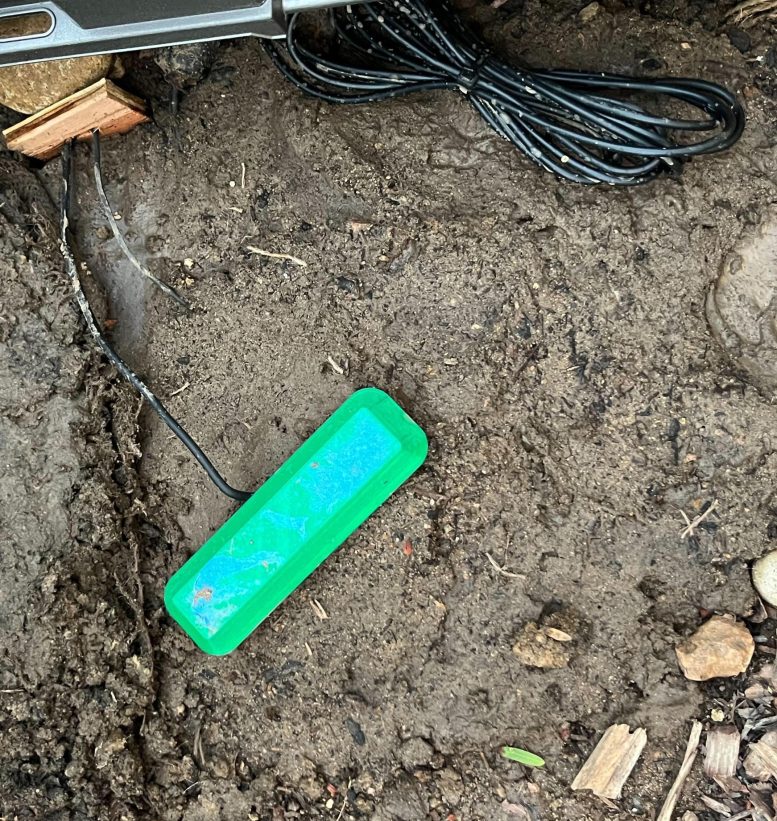
Northwestern University researchers have introduced a soil-microbe-powered fuel cell, significantly outperforming similar technologies and providing a sustainable solution for powering low-energy devices, with full public access to its designs for widespread application. The fuel cell’s 3D-printed cap peeks above the ground. The cap keeps debris out of the device while enabling air flow. Credit: Bill Yen/Northwestern University
A Northwestern University-led team of researchers has developed a new fuel cell that harvests energy from microbes living in dirt.
About the size of a standard paperback book, the completely soil-powered technology could fuel underground sensors used in precision agriculture and green infrastructure. This potentially could offer a sustainable, renewable alternative to batteries, which hold toxic, flammable chemicals that leach into the ground, are fraught with conflict-filled supply chains, and contribute to the ever-growing problem of electronic waste.
To test the new fuel cell, the researchers used it to power sensors measuring soil moisture and detecting touch, a capability that could be valuable for tracking passing animals. To enable wireless communications, the researchers also equipped the soil-powered sensor with a tiny antenna to transmit data to a neighboring base station by reflecting existing radio frequency signals.
Not only did the fuel cell work in both wet and dry conditions, but its power also outlasted similar technologies by 120%.
The research will be published today (Jan. 12) in the Proceedings of the Association for Computing Machinery on Interactive, Mobile, Wearable, and Ubiquitous Technologies. The study authors also are releasing all designs, tutorials, and simulation tools to the public, so others may use and build upon the research.
“The number of devices in the Internet of Things (IoT) is constantly growing,” said Northwestern alumnus Bill Yen, who led the work. “If we imagine a future with trillions of these devices, we cannot build every one of them out of lithium, heavy metals, and toxins that are dangerous to the environment. We need to find alternatives that can provide low amounts of energy to power a decentralized network of devices. In a search for solutions, we looked to soil microbial fuel cells, which use special microbes to break down soil and use that low amount of energy to power sensors. As long as there is organic carbon in the soil for the microbes to break down, the fuel cell can potentially last forever.”
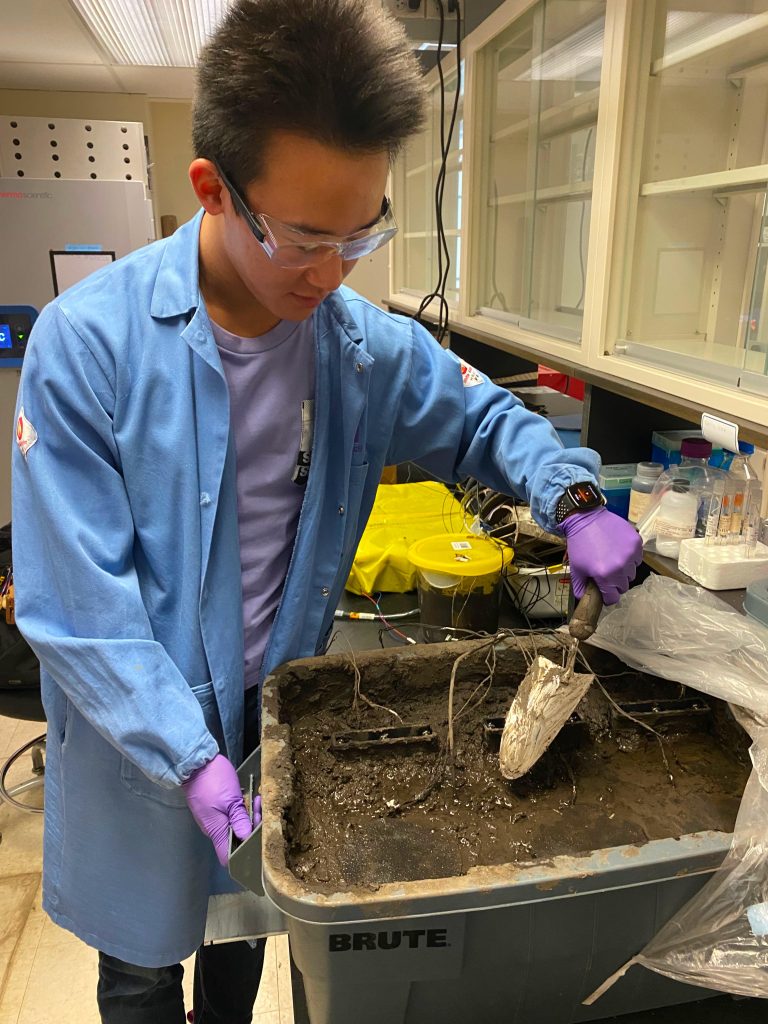
Bill Yen, the study’s lead author, buried the fuel cell during testing in the lab at Northwestern University. Credit: Northwestern University
“These microbes are ubiquitous; they already live in soil everywhere,” said Northwestern’s George Wells, a senior author on the study. “We can use very simple engineered systems to capture their electricity. We’re not going to power entire cities with this energy. But we can capture minute amounts of energy to fuel practical, low-power applications.”
Wells is an associate professor of civil and environmental engineering at Northwestern’s McCormick School of Engineering. Now a Ph.D. student at Stanford University, Yen started this project when he was an undergraduate researcher in Wells’ laboratory.
Solutions for a dirty job
In recent years, farmers worldwide increasingly have adopted precision agriculture as a strategy to improve crop yields. The tech-driven approach relies on measuring precise levels of moisture, nutrients, and contaminants in soil to make decisions that enhance crop health. This requires a widespread, dispersed network of electronic devices to continuously collect environmental data.
“If you want to put a sensor out in the wild, in a farm, or in a wetland, you are constrained to putting a battery in it or harvesting solar energy,” Yen said. “Solar panels don’t work well in dirty environments because they get covered with dirt, do not work when the sun isn’t out, and take up a lot of space. Batteries also are challenging because they run out of power. Farmers are not going to go around a 100-acre farm to regularly swap out batteries or dust off solar panels.”
To overcome these challenges, Wells, Yen, and their collaborators wondered if they could instead harvest energy from the existing environment. “We could harvest energy from the soil that farmers are monitoring anyway,” Yen said.
‘Stymied efforts’
Making their first appearance in 1911, soil-based microbial fuel cells (MFCs) operate like a battery — with an anode, cathode, and electrolyte. But instead of using chemicals to generate electricity, MFCs harvest electricity from bacteria that naturally donate electrons to nearby conductors. When these electrons flow from the anode to the cathode, it creates an electric circuit.
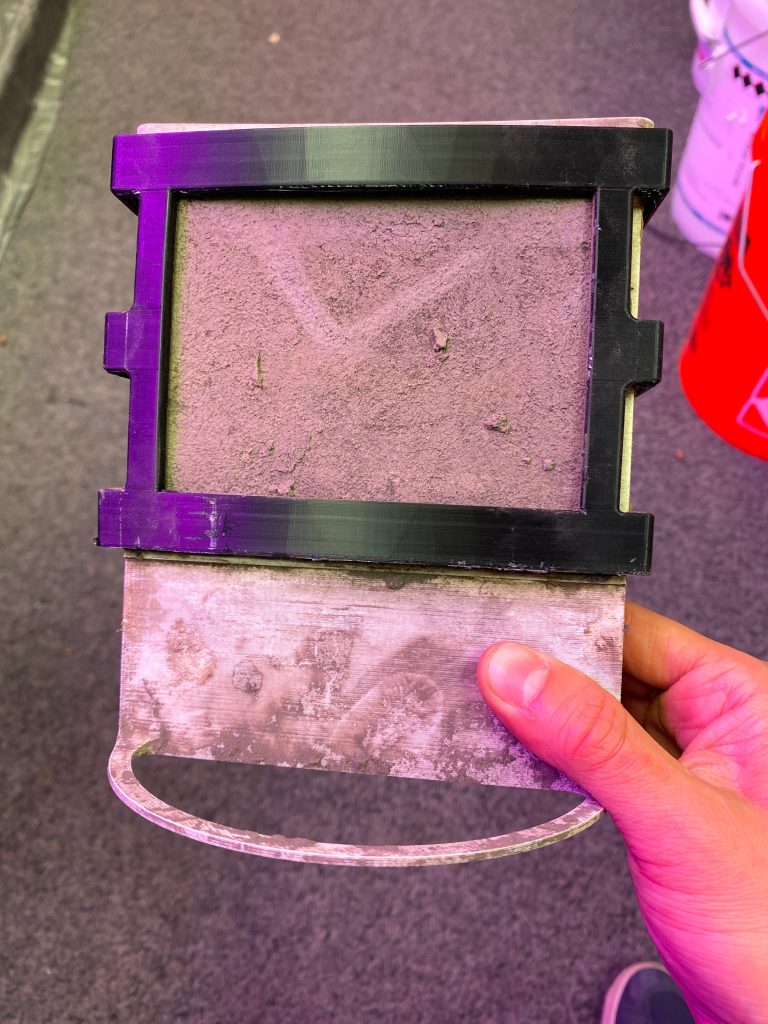
The fuel cell, covered in dirt after being extracted from the ground for studies. Credit: Bill Yen/Northwestern University
But in order for microbial fuel cells to operate without disruption, they need to stay hydrated and oxygenated — which is tricky when buried underground within dry dirt.
“Although MFCs have existed as a concept for more than a century, their unreliable performance and low output power have stymied efforts to make practical use of them, especially in low-moisture conditions,” Yen said.
Winning geometry
With these challenges in mind, Yen and his team embarked on a two-year journey to develop a practical, reliable soil-based MFC. His expedition included creating — and comparing — four different versions. First, the researchers collected a combined nine months of data on the performance of each design. Then, they tested their final version in an outdoor garden.
The best-performing prototype worked well in dry conditions as well as within a water-logged environment. The secret behind its success: Its geometry. Instead of using a traditional design, in which the anode and cathode are parallel to one another, the winning fuel cell leveraged a perpendicular design.
Made of carbon felt (an inexpensive, abundant conductor to capture the microbes’ electrons), the anode is horizontal to the ground’s surface. Made of an inert, conductive metal, the cathode sits vertically atop the anode.
Although the entire device is buried, the vertical design ensures that the top end is flush with the ground’s surface. A 3D-printed cap rests on top of the device to prevent debris from falling inside. And a hole on top and an empty air chamber running alongside the cathode enable consistent airflow.
The lower end of the cathode remains nestled deep beneath the surface, ensuring that it stays hydrated from the moist, surrounding soil — even when the surface soil dries out in the sunlight. The researchers also coated part of the cathode with waterproofing material to allow it to breathe during a flood. And, after a potential flood, the vertical design enables the cathode to dry out gradually rather than all at once.
On average, the resulting fuel cell generated 68 times more power than needed to operate its sensors. It also was robust enough to withstand large changes in soil moisture — from somewhat dry (41% water by volume) to completely underwater.
Making computing accessible
The researchers say all components for their soil-based MFC can be purchased at a local hardware store. Next, they plan to develop a soil-based MFC made from fully biodegradable materials. Both designs bypass complicated supply chains and avoid using conflict minerals.
“With the COVID-19 pandemic, we all became familiar with how a crisis can disrupt the global supply chain for electronics,” said study co-author Josiah Hester, a former Northwestern faculty member who is now at the Georgia Institute of Technology. “We want to build devices that use local supply chains and low-cost materials so that computing is accessible for all communities.”
Reference: “Soil-Powered Computing” by Bill Yen, Laura Jaliff, Louis Gutierrez, Philothei Sahinidis, Sadie Bernstein, John Madden, Stephen Taylor, Colleen Josephson, Pat Pannuto, Weitao Shuai, George Wells, Nivedita Arora and Josiah Hester, 11 January 2024, Proceedings of the ACM on Interactive, Mobile, Wearable and Ubiquitous Technologies.
DOI: 10.1145/3631410
The study was supported by the National Science Foundation (award number CNS-2038853), the Agricultural and Food Research Initiative (award number 2023-67021-40628) from the USDA National Institute of Food and Agriculture, the Alfred P. Sloan Foundation, VMware Research and 3M.

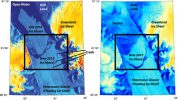






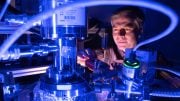
A long article without any valuable info. Annoying. 68 times more energy than what? W/O mA or mW it is a theoretical sb researched sg thing. I would not tell anything if they would provide the structure of the cell at least, electrons go from here to here etc..
I guess these researchers just want to catch some sponsors for their research but did not do anything yet just made a photo of a sandy 3d printed something…
Finally, a sustainable alternative to traditional batteries. The associated paper gives more detail as to how it works. How very creative of the team… There is a light at the end of the tunnel. Let’s all work to get there.
We’ve achieved ancient technology. The end is near
Please don’t use superlatives in your titles.
My fellow energy friends,
This is a small twist on the “Earth Batteries” that have been around forever. Tearing down old Civil War telegraph stations, discovering “cables” into the ground with power still in the wires! Earth Battery power source. Google it, check out and do a USA Patent Office search… been around for years. Make as large as you wish for more power, stringing them all together in the ground. Nothing new, same stuff, different day. Oh yes, “The Sea Of Energy In Which The Earth Floats” by T Henry Moray (1920s time period) a good read too.
Open up your eyes and minds to what is out there and learn more.
Kent Abbott – Kalispell Montana.
How is this different than what Tesla discovered?
So now we have electronics eating microbes that plants need to eat in order to survive?
I posted a reply to this a couple posts down, before I saw where the reply button was. D’oh!
Green revolution everywhere Great innovation of soul microbe based fuel cells.
Great green technology innovation of soil based microbe based fuel cells.
Jeremiah McKenna, as I understand it, the fuel cell simply accepts electrons that the microbes are giving off as a by-product. I could be mistaken, though.
Ready for something that really works? I found this by a lot of trial and error but I hope to inspire you to believe I sell no lies.
1.) Make a 48v solar array (don’t buy anything else, no charge controllers, no batteries, no inverters, nothing that could go wrong). By the way I started with less strings of 48v but I’m up to 6 now and am content with 6 to keep my hot water tank with hot water, cook for free and heat for free using DIRECT ENERGY APPLICATION (*I named it DEA ‘-) and have been living like this since 2016.
2.) Connect the two wires from your solar array directly to a water heater tank (it DOES NOT matter which way you connect the wiring unless you intend to use the thermostat, which you should probably pull out and convert to the dc thermostat). I don’t use the thermostat and simply know when my water is hot enough to shower with.
3.) Now that you accomplished hot water, with the SAME ARRAY OF SOLAR, also connect to as many hot plate cookers (or anything with an element) for free heating and cooking whether it’s sunny out or cloudy. You will first need to gut the ac stuff out of the heater (or bypass it all and simply solder your two solar wires to the element using your own switch to turn it off). Again, it doesn’t matter which way you connect the wires.
4.) THIS IS NOT ALL (*We have tons of free lights that appear at dawn and go off at dusk automatically for us and more!).
*****What else can you do with this free energy during the day time? Make it do something else to create the free energy you will need in the nighttime.
The aforementioned is nothing new (but finding any information on direct energy on the internet will prove to be challenging now that the “14 eyes” countries have censored our information and communications so thoroughly), however I am certain that the poor of our world woud certainly appreciate the affordable method (and simply don’t know that a couple hundred dollars will give them showers and cooked food for the rest of their natural born lives (if 110v didn’t burn up the devices and elements, 48v sure isn’t going to do it either and will probably prolong your cooker for the remainder of your life or until the sun peters out; whichever comes first).
amen
Actually, lower voltage can more easily burn through wires. Take a look at those fat wires attached to your starter battery some time.
And you need a well-marked emergency cut off on the side of the house for firemen, or they will not save your house.
I built a solar water heater, no electricity involved. More efficient, and cheaper…unfortunately it had very limited hours it was hot, and it was less reliable (water would boil and burst the thin irrigation black plastic tubing, I was using). I have a new design that addresses all the issues. When I get around to it, I will build it. Some of it is together.
Going to build a second one to heat a big metal feeding trough, I am using as a hot tub.
Too bad the invention will never see the light of day. It’ll be disappeared into a black book deemed too dangerous for humanity cause it would threaten the battery companies. But magically will become a Chinese invention and they’ll use it widely for all their applications and get ahead technologically. While the people who discovered it throw their pearls to swine. Yeah I’m so happy about this new discovery… now quickly give the credit to someone else and some other nation.
All these words and no mention of the actual power output !!
They absorb background radiation as a byproduct. Just saying.
Theoretically about 78 Gm per wat or volt. it’s called electronegativity. the electron is ionized generating a muted low sub 3 Hertz frequency. Near and sub gamma rays.
There’s nothing new under the sun.
snarp. geeble gooble garp??? ha!!!!!!!!! barp!!!